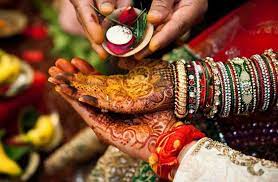Matrimonial-services

August 16, 2022 | matrimony-services
Marriage Rituals of Other Matrimony services
The rituals of weddings are many in number and involve not only the bride and groom but also the family members and even the community. There many religious rites are performed before and during the Nripas. Every wedding ceremony has a different significance. However, It varies from Communities and religions.
Hinduism believes that there are four stages of life and the householder is the second stage of life. It is the time of life when two persons come together and learn the real values of life through the institution of marriage.
The various rituals performed during the matrimonial ceremony have emerged from the ceremonies and ancient customs dating back to the Vedic times. Although customs and traditions differ from region to region, there are thirteen basic wedding rituals.
Pre-wedding rituals
One of the earliest rituals is the mishri or 'ring ceremony'. Lagna Patra & agreement between is a pre-wedding ceremony. It proceeds with 'Mehndi Ceremony' and 'Sangeet Ceremony'. The practice of Sangeet and Mehndi has some similarities in the northern and western regions of the country. However, a notable difference is observed in the eastern and southern parts of India. The members of each family, who are related to the bride's ties, decorate the groom's relatives with perfumes, costumes and flowers.
, 'Griha Puja' is the other essential pre-wedding ritual where the priest performs the puja with rice, coconut, wheat grains, oil, betel nut, turmeric and other spices.
The actual marriage ceremony begins with the ceremony of Var Satkarah in which the groom and his friends and relatives are welcomed and welcomed at the entrance of the hall where the wedding is to take place. The cleric priests chant mantras and the bride's mother blesses the groom. She also applies tilak made of vermilion and turmeric on her forehead. This is followed by the 'Madhupark ceremony', where the groom is received at the altar and gifts are given to him by the bride's father.
In the 'Kanyadaan Ceremony', the father of the bride hands over his daughter to the groom. What follows is 'Viva Homa' which is a sacred fire ceremony. It is conducted to ensure that all the various holy ceremonies that are about to take place begin on a pure and spiritual note. In the ritual of 'Pani Grahan', the groom takes the bride's right hand in his left hand and accepts her as his lawful wife.
The most important of the various celebrations is 'Saptapadi'. After the mangalsutra is tied, the Saptapadi is represented by the marriage knot, which ties one end of the groom's dupatta with the bride's dress. It is further represented with seven stages representing nourishment, strength, prosperity, happiness, progeny, long life, harmony and understanding respectively. Various religions follow the steps in their respective ways.
For example, in South Indian marriages, these seven steps are taken by holding the toe of the bride's right foot and then around the sacred fire towards the south. In some other marriages, the groom holds the bride's hand and leads her around the fire seven times. The deities are invoked at every step to shower their blessings on the couple. Wedding rituals include the final process of blessing or farewell by elders, followed by a farewell ceremony.
Post Wedding Rituals
Wedding rituals are an integral part of every Indian wedding ceremony. This does not stop with the departure of the bride from the husband's house. One of the most important post in Indian marriage rituals is 'Griha Pravesh', the time when the bride enters her husband's house for the first time. Modern Indian weddings usually involve hosting a reception ceremony by the groom's family. It gives well-wishers, especially those who could not attend the wedding, a chance to extend their blessings and wish the new couple all the best. These are some of the rituals, which are performed after marriage.
Thus a traditional wedding includes all these various rituals and customs.
